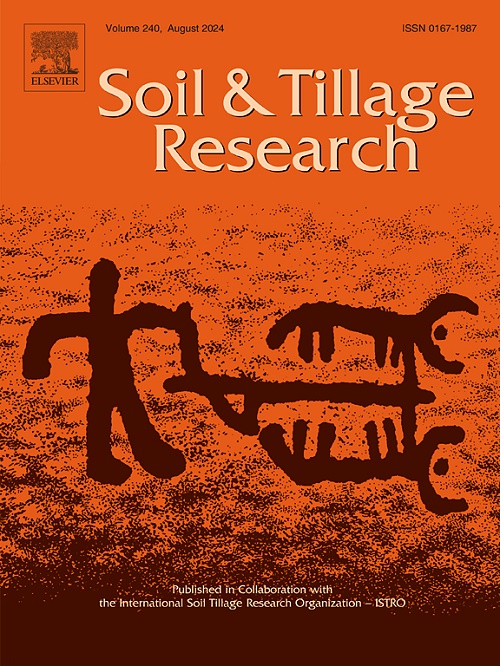Impact of Epichloë fungal endophyte-tall fescue symbiosis on mechanical characteristics of rooted soil depending on the host genotype
IF 6.1
1区 农林科学
Q1 SOIL SCIENCE
引用次数: 0
Abstract
Although the soil reinforcement by fibrous roots has been studied, the interaction impacts of endophyte symbiosis and plant genotype on mechanical characteristics of rooted soil have not been investigated yet. This study was conducted to explore the effects of endophyte symbiosis (Epichloë coenophiala) with tall fescue (Festuca arundinacea) genotypes (75B and 75 C) on root reinforcement of a sandy clay loam soil. Glasshouse grown plants with (E+) and without (E−) endophytes were tested for shear characteristics (i.e., shear strength, Sf, relative shear displacement, RSDf, and strain energy, Estrain) at depths of 10, 25 and 40 cm and two matric potentials (–10 and 0 kPa) measured using a large direct shear machine. Soil reinforcement by roots was related to root area ratio (RAR, ratio of root area to soil cross-section area), chemical composition and biomechanical characteristics (i.e., tensile strength, σY, and tensile strain-at-failure, ϵY, determined by an Instron universal tension-compression device). The roots increased Sf, RSDf and Estrain by 4.1x, 4.5x and 14.5x compared to the root-free soil, respectively, with endophytes causing a further increase for 75 C but not for 75B. Cellulose and cellulose/lignin ratio were higher in the 75 C roots than the 75B roots. Cellulose, cellulose/lignin ratio, σY and ϵY were always greater in the E+ plants than in the E− ones, although the effect of endophyte was more noticeable in 75 C. Largest reinforcement was recorded for 75 C E+ (i.e., Sf of 36.5 kPa, RSDf of 29.1 %, and Estrain of 5.89 kJ m−3), followed by 75B E+ > 75B E– ≈ 75 C E–, directly related to ruptured+stretched roots’ numbers, RAR, root cellulose, cellulose/lignin ratio, σY and ϵY. Compared to Sf and RSDf, the Estrain better discriminated the reinforcing effect of root/endophyte. Lower reinforcement was observed at saturated condition, and root/endophyte moderated the influence of matric potential on soil reinforcement. The 75 C roots (irrespective of endophyte) could effectively reinforce the soil (high slopes of Sf–RAR relations). But, the reinforcing effect of 75B E– roots was low and significantly increased due to endophyte presence. The 75 C roots predominantly reinforced upper layers while 75B roots mainly reinforced lower layers. In 75 C, endophyte’s effect was significant for depths > 10 cm; however, the endophyte’s effect in 75B was significant for depth of 10 cm. The 75 C roots could effectively reinforce soil irrespective of matric potential, but 75B roots mainly reinforced unsaturated soil. Overall, genotype selection of tall fescue associated with endophyte inoculation could improve capacity of this species to reinforce unstable slopes.
求助全文
约1分钟内获得全文
求助全文
来源期刊

Soil & Tillage Research
农林科学-土壤科学
CiteScore
13.00
自引率
6.20%
发文量
266
审稿时长
5 months
期刊介绍:
Soil & Tillage Research examines the physical, chemical and biological changes in the soil caused by tillage and field traffic. Manuscripts will be considered on aspects of soil science, physics, technology, mechanization and applied engineering for a sustainable balance among productivity, environmental quality and profitability. The following are examples of suitable topics within the scope of the journal of Soil and Tillage Research:
The agricultural and biosystems engineering associated with tillage (including no-tillage, reduced-tillage and direct drilling), irrigation and drainage, crops and crop rotations, fertilization, rehabilitation of mine spoils and processes used to modify soils. Soil change effects on establishment and yield of crops, growth of plants and roots, structure and erosion of soil, cycling of carbon and nutrients, greenhouse gas emissions, leaching, runoff and other processes that affect environmental quality. Characterization or modeling of tillage and field traffic responses, soil, climate, or topographic effects, soil deformation processes, tillage tools, traction devices, energy requirements, economics, surface and subsurface water quality effects, tillage effects on weed, pest and disease control, and their interactions.
 求助内容:
求助内容: 应助结果提醒方式:
应助结果提醒方式:


